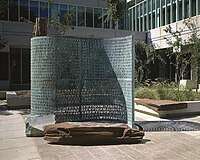User:Calmer Waters/Jim Sanborn sandbox
Jim Sanborn | |
|---|---|
| Nationality | |
| Known for | Photography, Sculpture, Writing |
Jim Sanborn (born 1945 in Washington, D.C.) is an American sculptor, best known for creating the encrypted Kryptos sculpture at CIA headquarters in Langley, Virginia.
Biography
[edit]Sanborn's father was the head of exhibitions at the Library of Congress, and his mother was a concert pianist and photo researcher. He grew up in Alexandria and Arlington, Virginia, attending JEB Stuart High School in Fairfax, and then attended Randolph-Macon College, receiving a degree in paleontology, fine arts, and social anthropology in 1968, followed by a Master of Fine Arts degree in sculpture from the Pratt Institute in 1971. He taught at Montgomery College in Rockville, Maryland, and then for nine years was the artist-in-residence at Glen Echo Park.
Art
[edit]His artwork has been displayed at High Museum of Art, the Los Angeles County Museum of Art, the Corcoran Gallery of Art, and the Hirshhorn Museum and Sculpture Garden. He has created sculptural works for the Massachusetts Institute of Technology, the Central Intelligence Agency, and the National Oceanic and Atmospheric Administration. [1] Themes in his work have included "making the invisible visible", with many sculptures focusing on topics such as magnetism, the Coriolis effect, secret messages, and mysteries of atomic reactions.
Sculptures
[edit]While in England studying archaeology, Sanborn endeavored to create a structure out of stone to gain a better insight on Romanesque sculptures. [2] From this he has created many works of art that deal with invisible forces. These include the Coriolis effect and its use of Newton's laws of motion that governs the motion of an object in an inertial frame of reference. He has also worked on pieces that complimented the Earth's magnetic field using Lodestones. Other sculptures have featured the science of cryptography. One of Sanborn's most famous works titled Kryptos was announced to be featured in Dan Brown's new Novel The lost symbol.
Kyptos
[edit]
Kryptos is the first cyptographic sculpture made by Sanborn. It was presented to the Central Intelligence Agency (CIA) in Langley, Virgina, USA on November 3rd, 1990.
The sculpture has been both a puzzle and a mystery for those who hope to crack the cyphered messages contained within the sculpture's 2,000 alphabetic letters. In the 22 years since Kryptos was erected only three of the four sections have been confirmed to have been solved. No one has yet been able to solve the remaining 97-character message.[3] He has also said that should he pass away before the sculpture's code is cracked, there will be a "sort of historic record" left to verify the claim. [4]
Photography
[edit]Large scale projects
[edit]Atomic Time
[edit]Among Sanborn's works have been works of art that reach into the realms of Science and Experimental physics.
Literature
[edit]Sanborn has written a book titled In Atomic Time: Pure Science and Sculpture. The book includes images detailing his exhibit Atomic Time: Pure Science and Seduction inspired by the Manhattan Project. [5]
Selected works
[edit]- Kryptos, CIA, 1990. Embedded with four ciphers, it was intended as a challenge to the employees at the CIA. As of 2013, only three of the four messages have been deciphered.
- Cyrillic Projector, a sculpture installed at the University of North Carolina at Charlotte in 1997.
- A,A, University of Houston, erected in front of the UH library in 2004.[6]
- Lingua located at the Walter E. Washington Convention Center. It is said to contain historical text ranging from as far back as 1400 BC. [7]
- Critical Assembly, 2003, modeled the first atomic bombs and key experiments of the Manhattan Project, which ran at the Corcoran Gallery of Art.[8]
- Terrestrial Physics, 2009, which includes a full-scale working particle accelerator. It will premier in June 2010 as part of Biennial of the Americas.[9]
Awards and Grants
[edit]1982 National Endowment For The Arts Fellowship
1983 Kawasaki International Sculpture Symposium, Kawasaki Japan.
1983 Kawasaki International Sculpture Symposium, Kawasaki Japan.
1984 Virginia Commission On The Arts Fellowship.
1986 National Endowment For The Arts Fellowship.
1987 Kaoshiung Taiwan International Sculpture Symposium, Kaoshiung Taiwan.
1988 Awards In The Visual Arts Grant.
1988 Louis Comfort Tiffany Foundation Grant.
1990 Art Matters Inc. Grant.
1991 Virginia Museum Fellowship.
1992 Virginia Commission On the Arts Grant.
1992 Pollack Krasner Foundation Grant.
1997 Sirius Project Residency, Cork Ireland.
1994 Virginia Commission on The Arts Grant. [10]
Notes
[edit]"Oral history interview with Jim Sanborn, 2009, July 14-16". Smithsonian Institution: Archives of American Art. Smithsonian Institution. Retrieved 2009-10-26. {{cite web}}: Italic or bold markup not allowed in: |publisher= (help)
References
[edit]- ^ "James Sanborn". Cultural Programs of the National Academy of Sciences. National Academy of Sciences. Retrieved 2009-10-26.
{{cite web}}: Italic or bold markup not allowed in:|publisher=(help) - ^ Vasquez, Leticia (June 28, 2004). "Art that speaks for itself". The University of Houston. Retrieved 2009-10-29.
- ^ ""Kryptos" Story". Central Intelligence Agency. 2007-04-30. Retrieved 2009-10-27.
- ^ Zetter, Kim (2005-01-05). "Questions for Kryptos' Creator". Wired. Retrieved 2009-10-29.
- ^ Sanborn, Jim (01-02-2004). Jonathan P. Binstock (ed.). Atomic Time: Pure Science and Seduction. Corcoran Gallery of Art. ISBN 0886750725. Retrieved 10-25-2009.
{{cite book}}: Check date values in:|accessdate=and|date=(help) - ^ Vasquez, Leticia (June 28, 2004). "Art that Speaks for Itself Enlightens New Sculpture". University of Houston Today. Retrieved 2009-08-25.
{{cite web}}: External link in|publisher=|publisher=(help) - ^ "Walter E. Washington Convention Center Art Collection". Washington Convention Center Authority. 2009-09-06. Retrieved 2009-10-20.
- ^ Flynn, Michael (January/February 2004). "But is it art? (Bulletins)". Bulletin of the Atomic Scientists. doi:10.2968/060001003. Retrieved 2009-08-04.
{{cite web}}: Check date values in:|date=(help); External link in|publisher=|publisher=(help) - ^ Gopnik, Blake (August 25, 2009). "Sparking Interest Within the Sphere of Art". Washington Post. Retrieved 2009-08-25.
{{cite web}}: External link in|publisher=|publisher=(help) - ^ "Sanborn Resume" (PDF). PDF. Irvine Contempory. Retrieved 2009-10-28.
External links
[edit]- Elonka Dunin's Sanborn page (his photograph, short biography, complete list of works)
